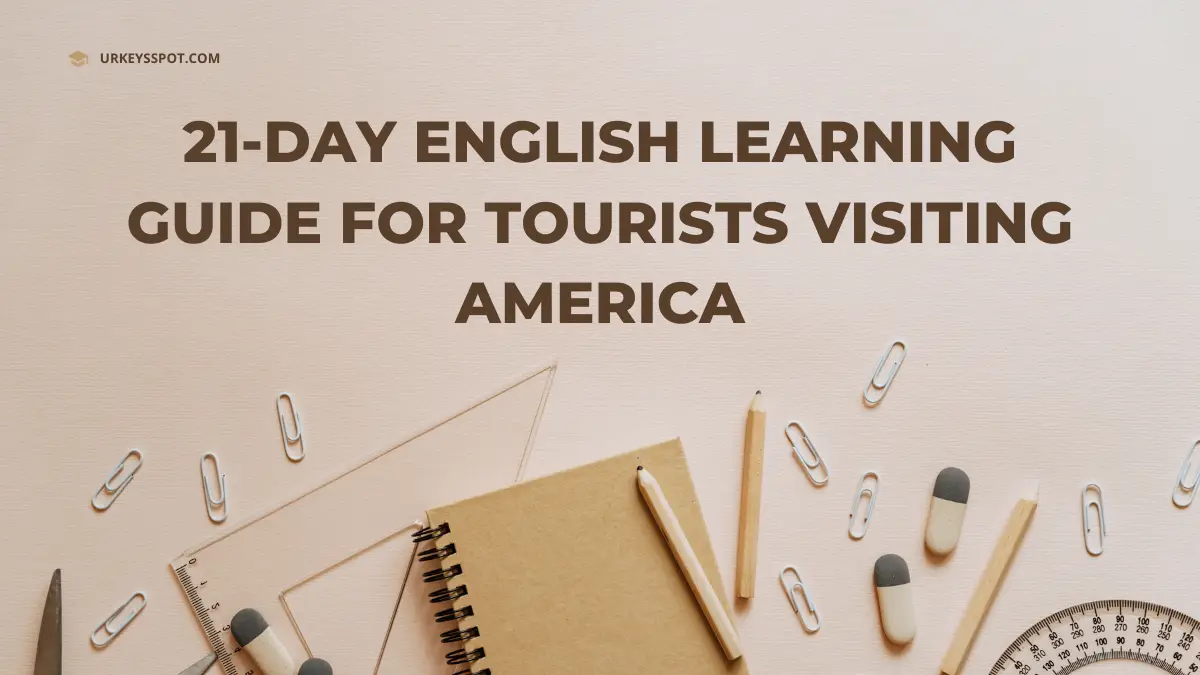Day English Learning Speak Vocabulary
Welcome, dear traveler, to the “Speak Like a Local: A 21-Day English Learning Guide for Tourists Visiting America!” Are you excited to explore the grandeur of America and worried about getting lost in translation? Fear not! This guide is your trusty sidekick, a linguistic map, ready to navigate you through the vast and diverse landscape of the English language. In just 21 days, you’ll go from stuttering tourist to savvy sojourner, mastering the local lingo faster than you can devour a Big Mac. Whether you’re ordering a coffee, hailing a taxi, or seeking the nearest restroom, we’re here to ensure your American experience is as smooth as the language you’ll soon be speaking. Buckle up, because in just one hour a day, you’re about to become an English-speaking tourist extraordinaire!
Explanation of the book’s purpose and structure – how it’s designed to help visitors in America communicate effectively in English in 21 days.
This guidebook is intentionally structured to help you, the traveler, assimilate the nuances of American English within a span of 21 days. Each day presents a new module, targeting specific situations you’re likely to encounter while touring America. Topics range from common phrases used in restaurants, directions for navigation, etiquette in public transportation, to local slang, idioms, and cultural references. The guide is designed to not only teach you the language, but also to immerse you in the American culture, ensuring you can interact confidently and understand responses in return. To solidify learning, each module ends with practical exercises that mimic real-life scenarios. The aim is to gradually build your vocabulary and comprehension, day by day, leading you to master American English by the end of this 21-day journey.
Day 1 – Vocabulary and dialogues associated with booking and purchasing plane tickets.

Vocabulary and Phrases
Vocabulary:
- One-way ticket
- Round-trip ticket
- Direct flight
- Connecting flight
- Layover
- Departure
- Arrival
- Seat selection
- In-flight meal
- Baggage allowance
- Boarding pass
- Economy class
- Business class
- First class
- Confirmation number
Dialogues:
- Traveler: I would like to book a round-trip ticket to New York.
Agent: Sure, Could you please tell me the dates for departure and return?
- Traveler: Can I choose my seat for the flight?
Agent: Yes, would you prefer a window or aisle seat?
- Traveler: How much luggage am I allowed to take with me?
Agent: You’re allowed one carry-on and one checked bag.
- Traveler: I need to cancel my flight. Can I get a refund?
Agent: Yes, but there could be a cancellation fee, depending on the airline’s policy.
- Traveler: Is it a direct flight or will there be any layovers?
Agent: This flight will have a 2-hour layover at Chicago.
Day 2 – Airport Navigation: Language skills for checking in, going through security, and boarding the plane.
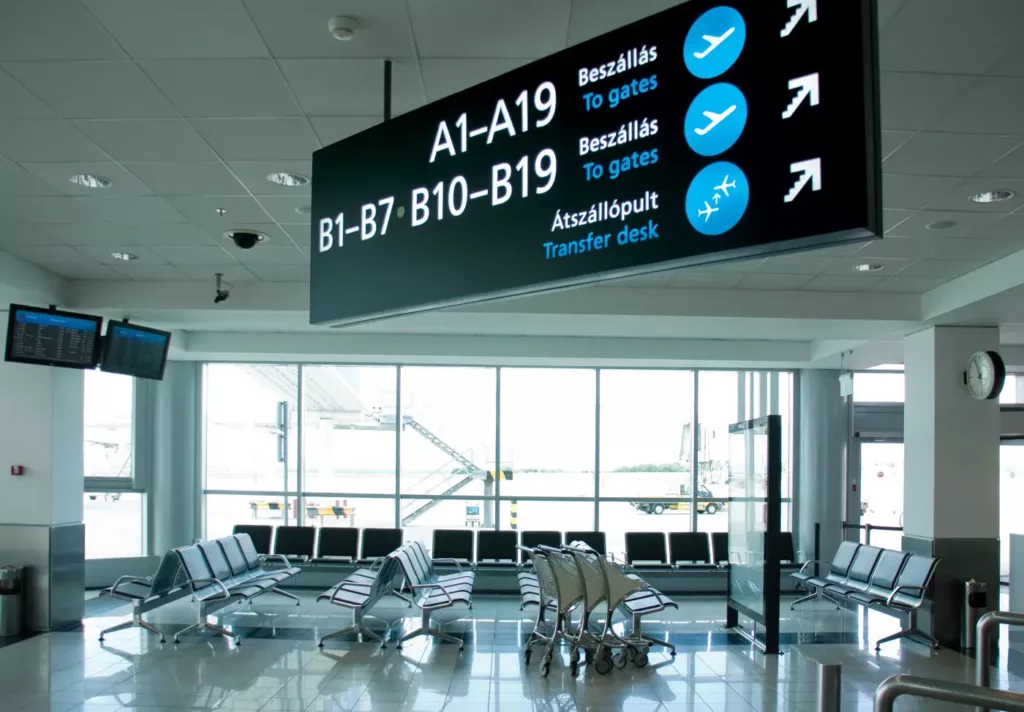
Vocabulary:
- Check-in desk
- Online check-in
- Boarding gate
- Boarding time
- Security check
- Passport control
- Duty-free
- Overhead bin
- Seat belt
- In-flight safety demonstration
- Takeoff
- Landing
- Turbulence
- Customs
- Baggage claim
Dialogues:
- Traveler: Where is the check-in desk for Flight 123?
Airport Staff: It’s on your left, next to the information desk.
- Traveler: What time does boarding start?
Airport Staff: Boarding starts 45 minutes before the flight time.
- Traveler: How long does the security check usually take?
Airport Staff: It usually takes 15-20 minutes, but it could be longer during peak hours.
- Traveler: Where can I find my boarding gate?
Airport Staff: Your boarding gate number is on your boarding pass, and there are signs throughout the airport.
- Traveler: I have some duty-free shopping to pick up. Where can I do that?
Airport Staff: You can collect your duty-free purchases at the collection point past the security check.
- Flight Attendant: Please stow your carry-on luggage in the overhead bin and make sure your seat belt is fastened.
- Customs Officer: Do you have anything to declare?
Traveler: No, I don’t have anything to declare.
- Traveler: Where can I collect my checked luggage?
Airport Staff: You can collect your checked luggage at the baggage claim area, the screens will display which carousel your flight’s luggage will be on.
Day 3 – In-flight Conversation: Practice asking and answering common questions during the flight.
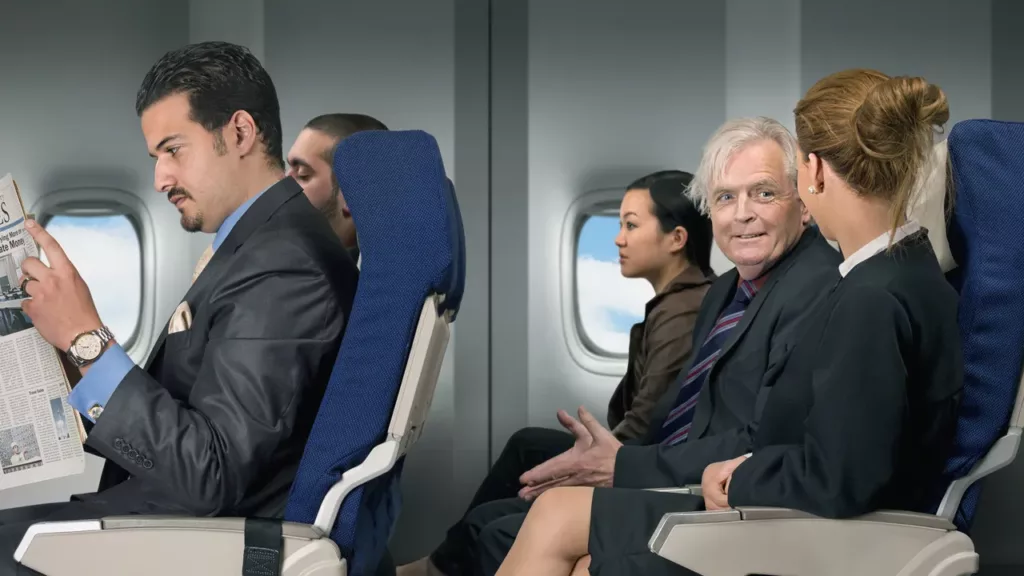
Vocabulary:
- Beverage service
- In-flight entertainment
- Meal service
- Duty-free shopping
- Flight attendant call button
- Restroom
- Emergency exit
- Fasten seatbelt sign
- Turbulence
- Altitude
- Estimated arrival time
Dialogues:
- Traveler: Could you please tell me when the beverage service will start?
Flight Attendant: The beverage service will start shortly after takeoff.
- Traveler: How can I access the in-flight entertainment?
Flight Attendant: You can use the touch screen in front of your seat to access our in-flight entertainment.
- Traveler: Can I have a vegetarian meal?
Flight Attendant: Yes, of course. I’ll make sure you get a vegetarian meal during our meal service.
- Traveler: How can I purchase items from the duty-free cart?
Flight Attendant: You can purchase items when we start the duty-free service, using a credit card.
- Traveler: Where is the restroom?
Flight Attendant: The restrooms are located at the back of the plane and in the middle section.
- Traveler: What should I do if there’s turbulence?
Flight Attendant: Please return to your seat and fasten your seatbelt immediately during turbulence.
- Flight Attendant: We are currently cruising at an altitude of 35,000 feet. Our estimated arrival time is 3:30 PM local time.
Day 4 – Arrival and Immigration: What to say when claiming bags and passing through immigration and customs.
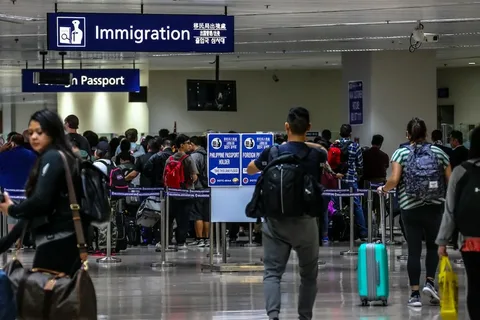
Vocabulary:
- Immigration form
- Passport
- Visa
- Customs declaration form
- Duty-free allowance
- Goods to declare
- Baggage claim
- Lost luggage
- Customs officer
- Border control
- Green channel (nothing to declare)
- Red channel (goods to declare)
Dialogues:
- Immigration officer: Can I see your passport and immigration form, please?
Traveler: Here you are.
- Immigration officer: What is the purpose of your visit?
Traveler: I’m here for tourism.
- Immigration officer: How long do you plan to stay?
Traveler: I will be staying for two weeks.
- Customs officer: Do you have anything to declare?
Traveler: No, I don’t have anything to declare.
- Traveler: Excuse me, where can I find the baggage claim area?
Airport staff: You can follow the signs for baggage claim, it’s just down this corridor.
- Traveler: I can’t find my luggage. What should I do?
Airport staff: Please go to the lost luggage counter. They will be able to assist you.
Day 5 – Transportation: Vocabulary and phrases for renting a car, taking a bus, subway, taxi, or train.
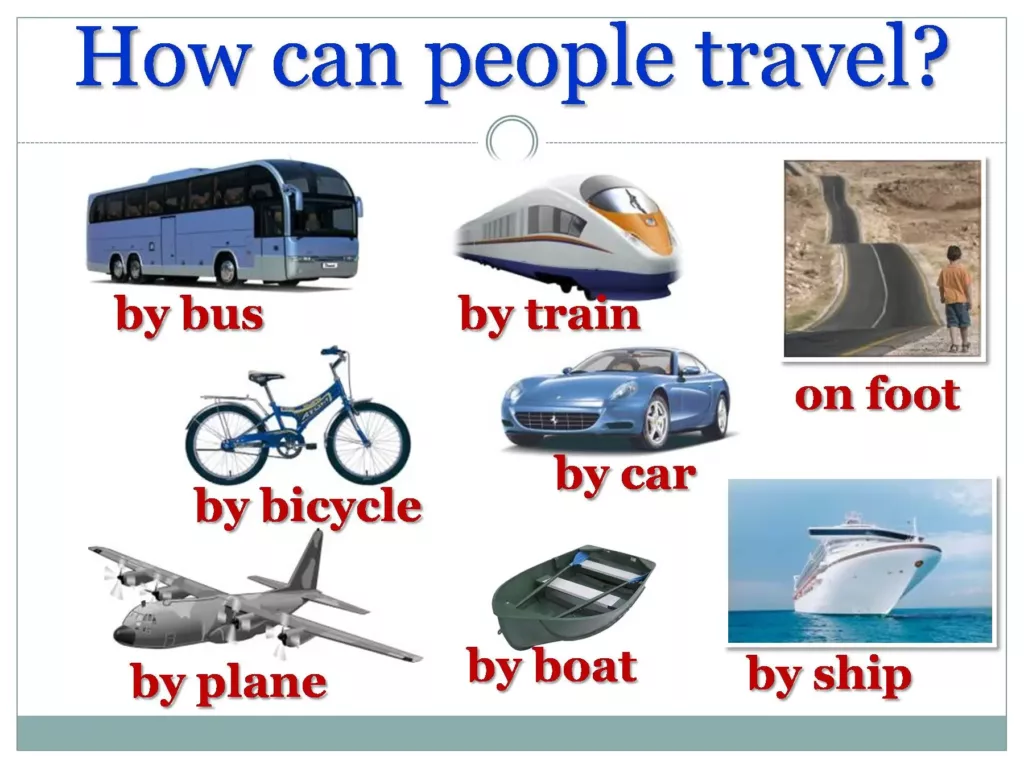
Vocabulary:
- Car rental
- Bus stop
- Subway station
- Taxi rank
- Train platform
- Schedule
- Route
- Fare
- Ticket
- Travel pass
- Arrival and departure times
- Peak and off-peak hours
- Transfers
- Directions
Dialogues:
- Traveler: Where can I find a car rental agency?
Local: There are several car rental agencies at the airport, just follow the signs.
- Traveler: How often does the bus come?
Local: The bus comes every 15 minutes during peak hours.
- Traveler: Can you tell me where the nearest subway station is?
Local: Sure, the nearest subway station is two blocks away on Main Street.
- Traveler: How much would a taxi to the city center cost?
Taxi Driver: It would cost around $25, depending on traffic.
- Traveler: How can I get to the train platform?
Station Staff: You can take the escalator down to the lower level.
- Traveler: What’s the fare for a single ticket to downtown?
Station Staff: A single ticket to downtown will be $3.
- Traveler: Where can I buy a travel pass for unlimited rides?
Station Staff: You can buy a travel pass at the ticket machines or at the ticket office.
- Traveler: Excuse me, could you tell me when the next bus arrives?
Local: Yes, the next bus arrives in about 10 minutes.
- Traveler: How do I transfer from the subway to the bus route?
Local: You can transfer at Central Station. There are signs indicating the bus routes.
Day 6 – Accommodation: Useful language for making hotel reservations, checking in and out.

Vocabulary:
- Reservation
- Check-in and check-out times
- Single room
- Double room
- Suite
- Bed and Breakfast
- Half board
- Full board
- All-inclusive
- Amenities
- Room service
- Concierge
- Front desk
- Deposit
- Cancellation policy
Dialogues:
- Traveler: I’d like to make a reservation for a double room.
Hotel Staff: Certainly, for what dates would you like to reserve the room?
- Traveler: What time is check-in and check-out?
Hotel Staff: Check-in is at 2pm and check-out is at 11am.
- Traveler: Do you have any suites available?
Hotel Staff: Yes, we have a few suites available. Would you like me to reserve one for you?
- Traveler: What does the room rate include?
Hotel Staff: The room rate includes breakfast and access to our gym and pool.
- Traveler: How can I cancel my reservation if I need to?
Hotel Staff: You can cancel your reservation by calling our front desk. Please note that cancellations must be made 48 hours prior to your check-in date to avoid any charges.
- Traveler: Can I request room service?
Hotel Staff: Yes, room service is available 24/7. You can find the menu in your room.
- Traveler: I’m ready to check out now.
Hotel Staff: Sure, let’s settle your bill. Did you use any items from the mini bar?
- Traveler: Where can I store my luggage after check-out?
Hotel Staff: We have a storage room available. Our concierge can assist you.
Day 7 – Eating Out: How to order food in restaurants, bars, and coffee shops.

Vocabulary:
- Menu
- Specials
- Appetizers
- Main course
- Dessert
- Beverage
- Vegetarian
- Vegan
- Gluten-free
- Allergies
- Bill/Check
- Tip/Gratuity
- Dining in
- Take out
- Reservation
Dialogues:
- Waiter: Good afternoon, would you like to see the menu?
Traveler: Yes, please. Could you also tell me the specials for today?
- Traveler: I’d like to order the chicken Caesar salad for appetizer and the grilled salmon for the main course.
Waiter: Excellent choice, would you like any drinks with your meal?
- Traveler: I am a vegetarian. Could you recommend a dish without any meat?
Waiter: Absolutely, our vegetable lasagna is very popular among our vegetarian customers.
- Traveler: I have a peanut allergy. Could you ensure my food doesn’t contain any peanuts?
Waiter: Of course, we’ll make sure of that. Thanks for letting us know.
- Traveler: Could I get the check, please?
Waiter: Sure, I will bring it right away.
- Traveler: How much is usually given for a tip here?
Waiter: Typically, a tip of 15-20% of the total bill is given, depending on the quality of service.
- Traveler: I’d like to make a reservation for dinner at 7 pm tonight.
Restaurant Staff: Sure, we have a table available at that time. Could I have your name, please?
- Traveler: Can I order this to go?
Waiter: Certainly, I’ll prepare it for take away.
- Traveler: Do you offer any gluten-free options?
Waiter: Yes, we do. You can find our gluten-free options marked on the menu.
Day 8 – Shopping: Essential phrases for shopping and asking for prices at various outlets.

Vocabulary:
- Shop/Store
- Market
- Salesperson
- Customer
- Price
- Discount
- Sale
- Bargain
- Receipt
- Cash
- Credit Card
- Return Policy
- Exchange
- Fitting Room
- Size
Dialogues:
- Customer: Excuse me, how much does this cost?
Salesperson: This item is $50.
- Customer: Is this item on sale?
Salesperson: Yes, it’s 20% off today.
- Customer: Can I pay with credit card?
Salesperson: Yes, we accept all major credit cards.
- Customer: What is your return policy?
Salesperson: You can return any item within 30 days of purchase with a receipt.
- Customer: Do you have this in a larger size?
Salesperson: Let me check for you. We do have that item in a larger size.
- Customer: Where are the fitting rooms?
Salesperson: The fitting rooms are just over there, to your right.
- Customer: Do you offer a discount for students?
Salesperson: Yes, we offer a 10% discount for students with a valid ID.
- Customer: I’d like to exchange this item.
Salesperson: Certainly, do you have your receipt?
- Customer: Can I try this on?
Salesperson: Of course, the fitting rooms are just over there.
- Customer: Could you help me find the electronics section?
Salesperson: Sure! It’s on the second floor.
Day 9 – Asking for Directions: Learning how to ask for and understand directions.
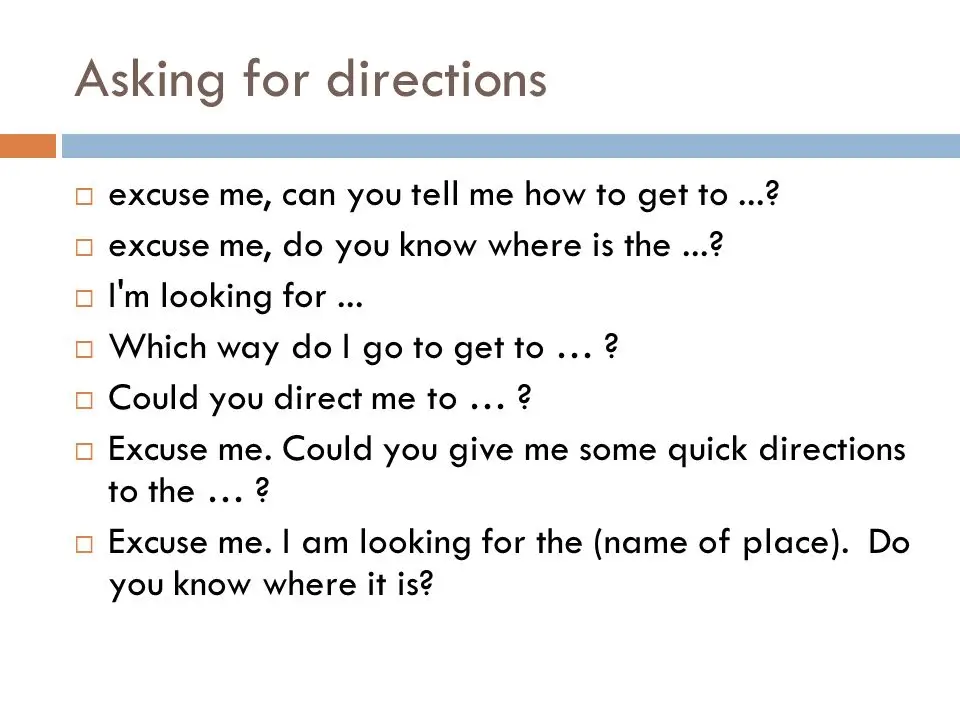
Vocabulary:
- North, South, East, West
- Left, Right, Straight ahead
- Intersection
- Traffic light
- Roundabout
- Landmark
- Map
- Distance
- Nearby
- Far
Dialogues:
- Traveler: Excuse me, could you tell me how to get to the train station?
Local: Sure, go straight ahead until you reach the next traffic light, then turn right. The train station is about two blocks down on your left.
- Traveler: Could you tell me where the nearest pharmacy is?
Local: Yes, there’s a pharmacy just around the corner to your left.
- Traveler: I’m looking for the museum. Is it far from here?
Local: No, it’s not far. It’s about a ten-minute walk. Continue down this street, then take a left at the roundabout. The museum is just past the park on your right.
- Traveler: I’m lost. Could you help me find my way back to Main Street?
Local: Certainly. Go back the way you came until you reach the intersection, then turn right. Keep going straight and you’ll find Main Street.
- Traveler: How do I get to the nearest subway station?
Local: Go straight on this road for about half a mile, then take a right at the third traffic light. The subway station entrance will be on your left.
- Traveler: Is there a supermarket nearby?
Local: Yes, there’s one to the west of here. It’s about a five-minute walk. Just keep going down this street and you will see it on your right.
Day 10 – Health and Safety: Basic phrases for expressing how you feel if you get sick.
Vocabulary:
- Sick
- Hurt
- Pain
- Fever
- Cough
- Cold
- Allergy
- Prescription
- Pharmacy
- Hospital
- Doctor
- Nurse
- Emergency
- Medicine
Dialogues:
- Traveler: I’m not feeling well, I think I have a fever.
Local: You should see a doctor. There’s a clinic nearby.
- Traveler: I’ve got a terrible headache.
Local: There’s a pharmacy close by where you can get some painkillers.
- Traveler: I think I ate something bad, my stomach hurts.
Doctor: I will give you a prescription for some medicine.
- Traveler: I’ve been coughing a lot lately.
Doctor: It sounds like you might have a cold. Let’s run some tests.
- Traveler: I’ve injured my leg and it’s really painful.
Local: You need to go to the hospital. I will call an ambulance.
- Traveler: I have a rash and I think it might be an allergic reaction.
Doctor: We need to find out what caused it. I’ll prescribe an antihistamine for now.
- Traveler: I feel dizzy and lightheaded.
Nurse: You should sit down and drink some water, I’ll check your blood pressure.
Day 11-21 – Cultural Insights & Tips: Important cultural tips, dos and don’ts, and more advanced conversational phrases. Each day tackles a different aspect of American culture and relevant language skills.
In conclusion, this comprehensive guide equips travelers with essential language skills and cultural insights for an enriching journey through the United States. It covers a wide range of real-life scenarios, providing key vocabulary and dialogues that will enable effective communication during travel, dining, shopping, seeking directions, addressing health concerns, and more. The guide also emphasizes the importance of understanding and respecting American culture, offering valuable tips, dos and don’ts, and advanced conversational phrases to help travelers navigate social situations with ease. By aligning their language use and behavior with local norms, travelers can enjoy a more authentic and respectful interaction with their hosts. With this guide, you’re not just learning a language, but immersing yourself in a rich and diverse culture.

